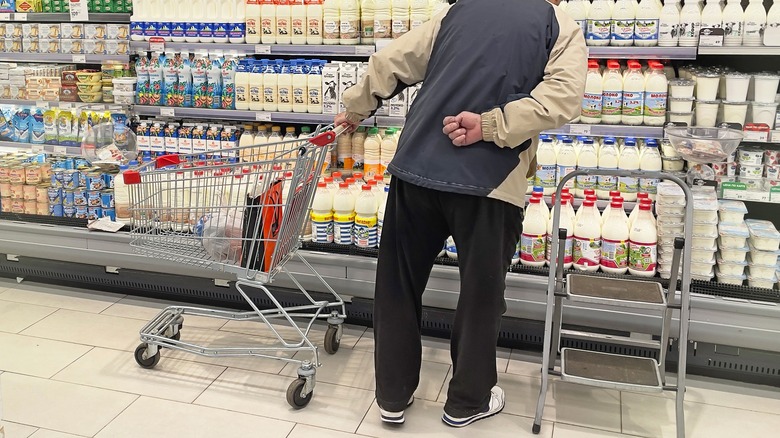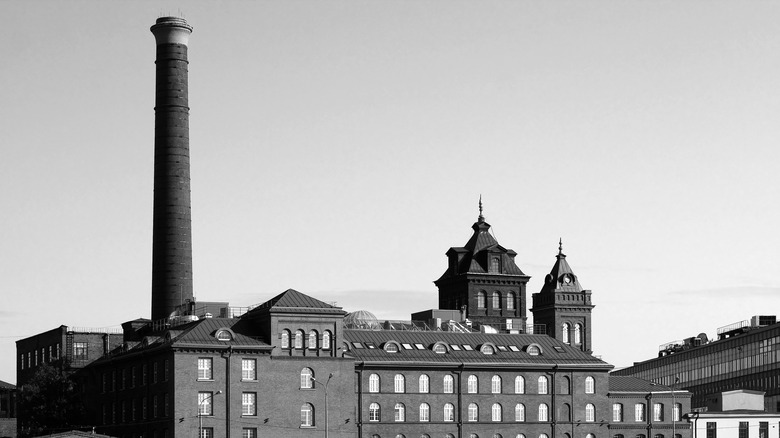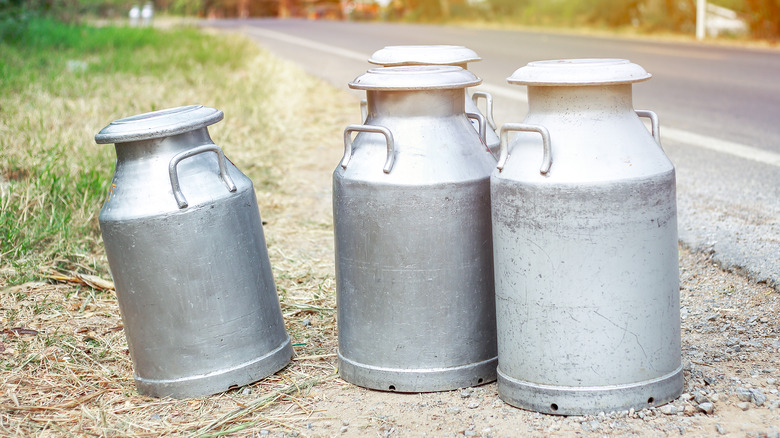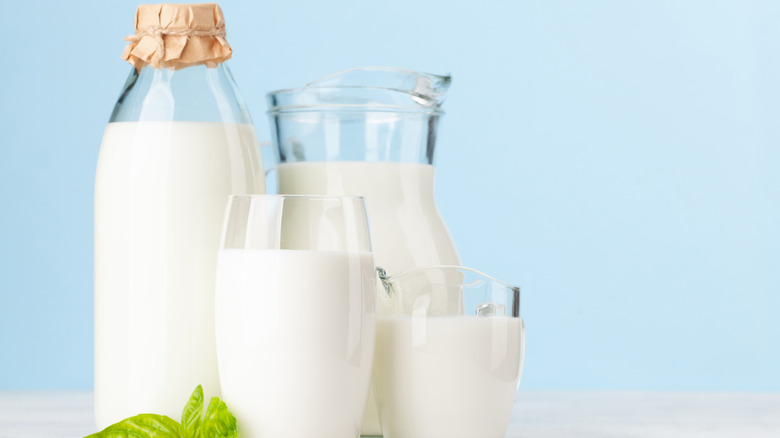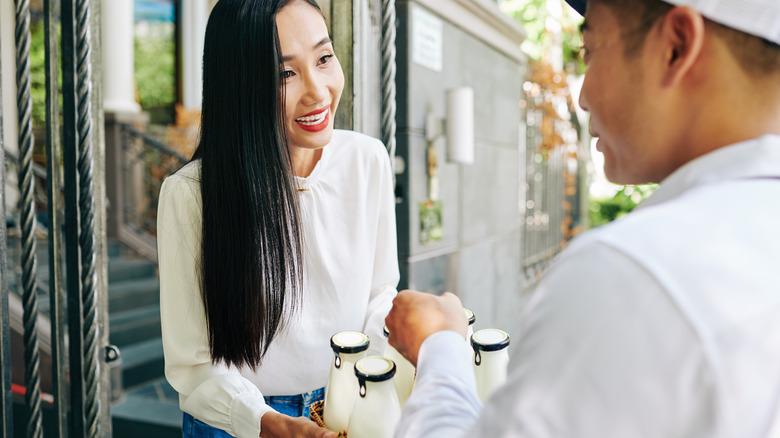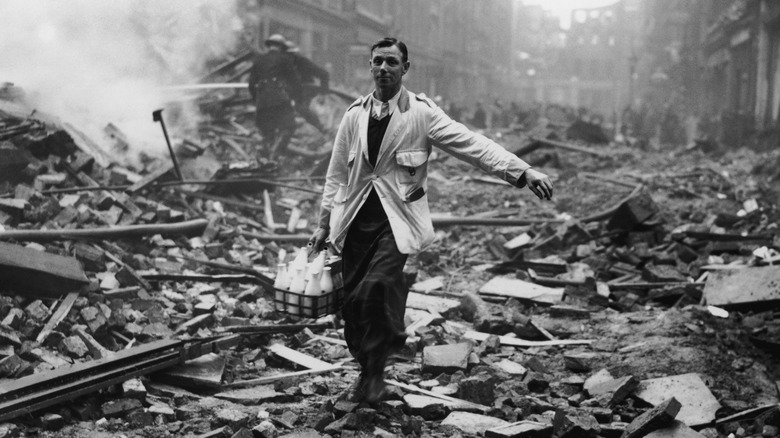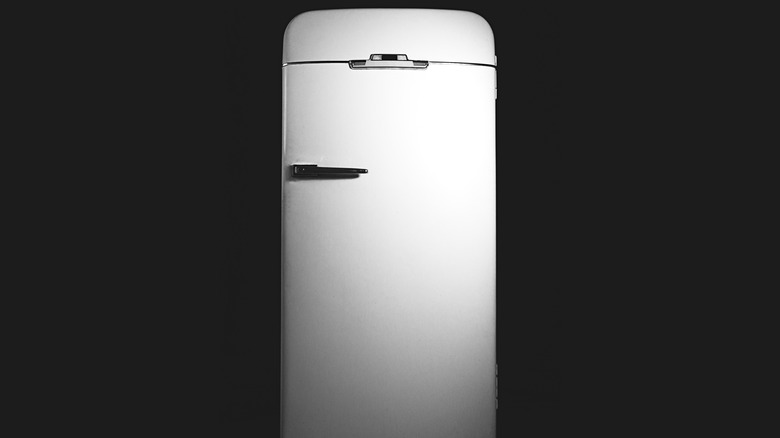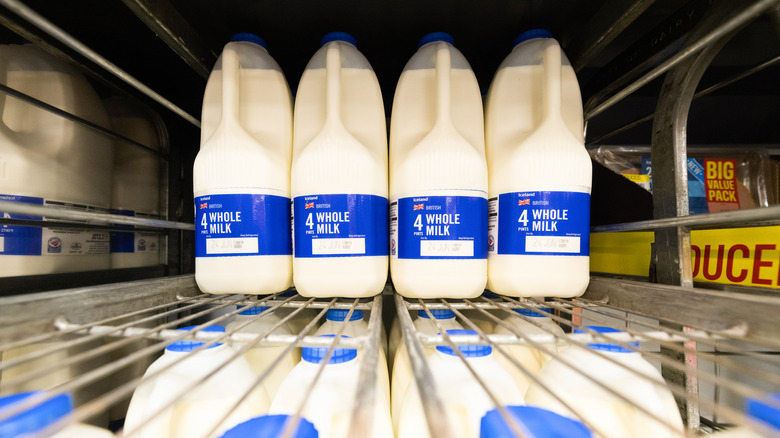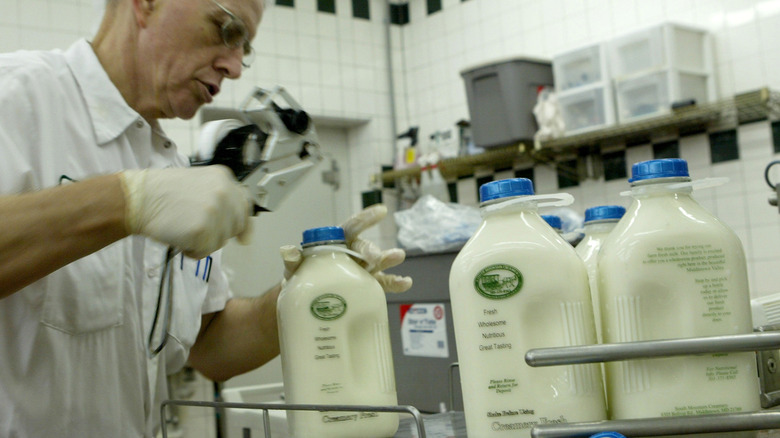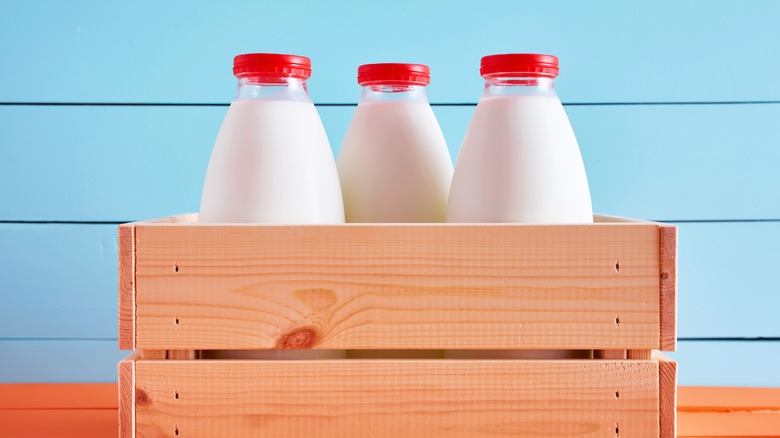The Rise And Fall Of The Milkman
Milk is something that is just a part of the American diet.
Advertising tells us on a routine basis that it makes us strong. We use it in our baked goods and creamy recipes. Even vegans and folks with lactose tolerance issues look for dairy alternatives, which means even people who don't drink literal milk need a substitute for the idea of milk. While we are the masters of our own milky ways right now, it wasn't long ago that there was one person responsible for taking care of a community's dairy needs — the milkman.
It's a job title that doesn't need an introduction despite being a fixture of daily life during a long-bygone era. Even online, when one confused Redditor asked if the U.S. had milkmen after a friend didn't understand a raunchy milkmen joke, tons of other posters weighed in on the topic, each with a different understanding of what the milkman is or was. The consensus was the most would recognize a milkman, or at least know what a milkman is, but agreed that in daily life, milkmen barely exist anymore. But how did a job that is so recognizable fall so far for everyday culture? Below is the history of the rise, and then fall, of the American milkman.
Milk has long been a popular dietary staple in the U.S.
Milk maintains an almost unshakable presence in the American diet; it's on the breakfast table, in our milkshakes, and a part of our childhoods. But really, its history starts with colonialism, as cows weren't originally native to the Americas.
Sentient Media observes that cattle farming was not a part of the American landscape until the 16th century and that the introduction and farming of cows can be seen as synonymous with colonial occupation and expansion. It was, in short, a means of control just as much as a means of subsistence. But, as one history professor commented in an interview with Mashed, food was hard to come by in the early American settlements. In addition, colonizers tried to stick with food that they were accustomed to back home.
Given the importance of dairy-heavy recipes in Europe at that point, those who were trying to survive in the Americas had to get by on foods they were used to. It wasn't supremely uncommon for a house to have a cow or two or produce dairy products in little structures adjacent to the main home called "milk houses." According to researchers at Colonial Williamsburg, bits of straw or snow would often be used to keep the milk cool. Keeping milk cool and clean was both extremely taxing and time consuming.
Milk delivery started in the 19th century
By the 19th century, the American continent looked a lot different. Colonization was complete, there had been a revolution against the British, and the geography of the U.S. was being settled. Food security was taking on new forms and facing new challenges. For one example, as outlined by Drinking Glass Milk Bottles, industrialization began to take root in the U.S. at this point in time. This meant that more and more people were moving to urban areas to find work and make a living. As the people moved, their diets more or less remained unchanged. By and large, Americans were still very accustomed to milk.
It wasn't usually possible to own a cow or a milk house in crowded cities, so innovative solutions came to fruition. Thus came the advent of the milkman as early as the late 18th century (via Drinking Glass Milk Bottles). While dairy creameries opened as a sort of prototype to the supermarket, milk deliveries became the chic solution. These deliveries would be made through one man who traveled around neighborhoods with a big metal container brimming with milk and dropped off amounts of dairy that households were accustomed to drinking and cooking with.
Milk arrived in whatever jugs were available
Milk delivery actually predates widespread consumer usage of glass bottles. Wired described the purchase of milk around the 19th century as much more of a bulk experience than it is today. Drinking Glass Milk Bottles clarifies that at the time, households used an array of containers to receive milk, including jugs or pails or whatever happened to be handy. If that doesn't sound sanitary, that's because it most certainly was not.
There was a major health concern surrounding this system. As Wired explained, milk delivery was rarely hygienic as big metal kegs were easily contaminated. As reported by the Corning Museum of Glass, it wasn't uncommon for these main milk barrels to be infested with anything from dirt to hair to insects. There was certainly a lot to improve upon, and thankfully, important innovations would shortly come to the milk delivery industry throughout the 20th century.
Behold, the glass milk bottle
According to the Corning Museum of Glass, the glass milk bottle was a direct reaction to health concerns surrounding milk delivery. Dr. Hervey Thatcher, a druggist located in New York, sought to design a method for mitigating the more unsavory aspects of milk delivery. The solution was surprisingly simple, and yet still complicated by the technological standards of the day.
By 1885, as noted by the aforementioned museum, Thatcher had invented what he dubbed the "The Milk Protector." The glass bottle was slightly bulbous and completed with a wooden stopper. It was, essentially, the first glass milk bottle or, if not quite the glass milk bottle we would recognize today, it was its immediate predecessor.
The glass bottles provided for individual fillings instead of communal fillings with a giant keg and ladle, and it reduced exposure and risk of the milk being sullied considerably. Wired observed that these early milk bottles could circulate as much as 22 times and would be sterilized regularly. While still not the cleanest option, the advent of clean(er) milk was upon American society by the turn of the century.
Milkmen established relationships with their neighborhoods
Of course, there are many raunchy jokes and tropes alluding to the exact nature of just how close the milkman got to the people he delivered to, specifically the women (via TV Tropes). But aside from perverse and occasionally accurate humor, milkmen were known for forming a special relationship with the neighborhoods they serviced. After all, if you see the same people every week, you inevitably bond with them to some degree. So unique was the relationship between these dairy deliverers and the neighborhoods they worked in that it even inspired at least one anthropological study.
So integrated was the milkman into households that there were sometimes special doors for him. According to The Smithsonian Magazine, small 2-foot doors were incorporated into some apartment buildings that allowed milkmen to deliver directly inside the apartment building. This had the added benefit of allowing those who were working, increasingly both men and women, to receive their milk without being home. Although the doors, according to the article, have long been painted shut, they remain a testament to the staying power of milkmen and their role in American society.
Milk delivery persisted through major historical events
Through the perils of history, the milkman even became a symbol of resistance in times of hardship. Similar to the U.S., the U.K. enjoyed a rich history of milkmen that supplied communities with dairy and dairy products.
During World War II, London was heavily impacted by Nazi bombing attacks. The city was in shambles, and the realities of war were unignorable for the country, much less the Londoners. According to War History Online, a photo of a stoic milkman working in uniform porting glass milk bottles among the ash and rubble quickly gained traction as a symbol of English resilience. Interesting to note, as the source explained, is that the milkman in this photograph wasn't a real milkman. The photographer's assistant borrowed the coat and milk crate of a passing milkman and together he and photographer Fred Morley sought to depict wartime in London. The photo to this day remains a reminder of the tenacity of the English force and country.
Photography wasn't the only morale-boosting aspect of English milkmen. Just after the war, in 1946, dignitary Edward Kenelm Digby took to delivering milk in the areas surrounding his stately manor as reported in one historical news article from Time. Related through marriage to Winston Churchill, the special milkman's visits incited passion, fervor, hope, and a little bit of stateliness in a rebuilding world.
The refrigerator spelled the end for milk delivery
The milkman persisted through time, geography, food security, and political hardship, so it was a given that milk would be delivered ... until it wasn't. As reported by one journalist over at The Smithsonian Magazine, there were a few separate events that altered the reality of milkmen in the U.S. For one, after the war, there was a major movement of majority white urban dwellers to the ever-growing suburbs. According to the magazine, this spelled out an inconvenience for milk deliverers. As their delivery routes expanded to cover larger swaths of land, the delivered milk began to also become more expense. Meanwhile, more and more Americans had access to a car and could acquire their groceries quickly, easily, and independently.
But there was one other development that threatened the longevity of milkmen — the personal refrigerator. According to Apartment Therapy, personal refrigeration at home was nothing short of a revolution that allowed for households to fully take control over the preservation of their food. As The Smithsonian observed, between people gaining more mobility, grocery stores becoming cheaper alternatives and an ever-expensive scope of milk delivery, home refrigeration spelled the end for milk delivery ... at least for a little while.
Milkmen disappeared throughout the '70s and '90s
Even as late as the 1920s, most households received milk delivered to their home according to The Smithsonian Magazine. But in the U.S. and U.K. deliveries saw a sharp decline in the period of time following the World War II. This, of course, was due to many different factors, but the trend was undeniable. In the U.S., perhaps because cars were more common, the change in milk purchasing patterns changed in practically an instant. As observed by the aforementioned source, as early as the '70s, as few as 15% of households received milk delivered to their doorstep. While 50 years is not a short amount of time, that's nonetheless a major difference in trend. This trend only continued as time went on. By the '90s, the number of milk deliveries dropped to less than 1%. Truly contemporary times meant, at least in the 20th century, that the era of the milkman had come to an end.
The U.K., which had a similar relationship to the milkman, underwent a similar but slower process. According to Bright Vibes, throughout the '60s, '70s, and '80s, the bulk of milk consumed by Brits was delivered to their doorsteps. Despite this, by the 21st century, less than 3% of milk consumed in England is of the delivered sort.
Milk delivery saw a resurgence in the '00s
The prevalence of milkmen had declined sharply by the mid-century, and certainly in the 21st century, virtually no one expects them to make a comeback. But in the early aughts, there were some rumblings that this American tradition was due for a comeback. But as reported by The New York Times in 2007, this was less out of necessity than it was out of nostalgia and perhaps luxury. A woman the Times interviewed celebrated not having to add extra grocery store runs to meet the needs of her 17-year-old dairy afficionado son and appreciated not having to carry so many gallons of milk around. Three years earlier, one Utah dairy farm celebrated what they saw as a nothing short of a renaissance in milk production. The dairy farmers' saw that online groceries could spell a rebirth of milk delivery, and it's true enough that with community shared agriculture, there came a time when home-delivered groceries returned to vogue.
Was there a milk delivery comeback during the pandemic?
It was around a decade later that the COVID-19 pandemic brought about a major comeback for localized milk delivery, as reported by CGTN. In 2020, as supply chains were majorly disrupted, both creameries and local inhabitants found themselves in a pickle. Both suppliers and consumers were dealing with canceled contracts and shortages, and it became clear that it could be cheaper and more stable to buy from local businesses once again. Notably, also according to CGTN, in comparison to years prior, the demand for milk had decreased. Nonetheless, there was enough of a lucrative market to offer home-delivery services for those who still wanted a cool glass of milk.
It seems like local dairy farms are hopping on the trend and hoping to encourage more milkmen, or milk person, services. One California-based organization, Drink Milk in Glass Bottles encourages would-be patrons to consider local benefits, freshness, convenience, and nostalgia as selling points for delivered milk. Perhaps the time for home-delivered milk is here upon us again.

